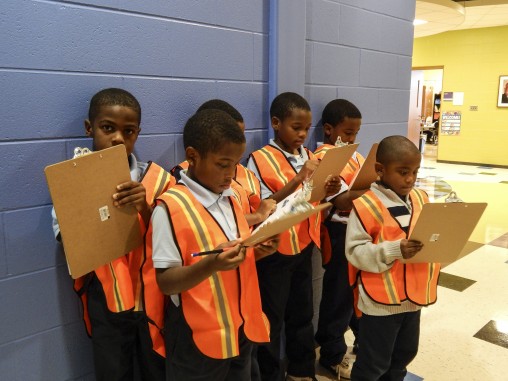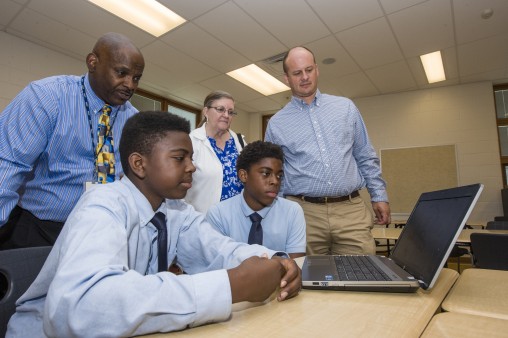
Students at the Dayton Boys Preparatory Academy tracked the number of vehicles passing by the school as part of a project to install a crosswalk near the school building.
The National Network for Educational Renewal has selected Wright State University’s College of Education and Human Services and the Dayton Boys Preparatory Academy partnership as its 2015 Richard W. Clark Partner School Award winner.
The award was announced at the NNER National Conference Oct. 1 and will be presented locally on Nov. 6 at 1 p.m.
The Richard W. Clark Award for Exemplary Partner School Work recognizes a partner school collaboration that advances the complex work of developing, sustaining and renewing partner schools. Clark, a leader in partner school research and practice that has influenced NNER partner schools, advocates for developing and sustaining quality partner schools that provide quality access to knowledge to all students, ensuring quality learning environments for preservice teachers, providing professional development for all adults engaged in the work and promoting a culture of inquiry for renewal of school practices.
Ann Foster and Greg Bernhardt, co-executive directors of NNER, said the partnership between CEHS and the academy demonstrated “remarkable vision and progress in critical aspects of partner school work dedicated to advancing quality learning for all.”
The NNER is a membership network dedicated to the simultaneous renewal of schools and the institutions that prepare our teachers.
Anna Lyon, associate professor in teacher education and early childhood program director at Wright State, has been the driving force behind the partnership with the academy that began in 2007–08.
The academy is one of five Professional Development School sites the college and the host schools use to create impactful learning opportunities for students and professionals through service-learning curricula.
Students like Ja’Lil Cantrell, through the partnership, identified and engaged in an effort to fix a long recognized problem for the boys and families who walked to his school.
“We could see through our project that we really need a crosswalk for our school,” said Cantrell. “I think it’s important. I really want to be safe when I cross the street.”
The crosswalk project came into existence through the Professional Development School partnership between the academy and Wright State.
“The teachers in these schools are really excited about the impact our teacher candidates can have on their students,” said Teacher Education Chair Jim Tomlin. “It also allows the field, not just theory, to drive our instruction.”
The instruction that Cantrell and others in the academy’s student body received involved studying the number and types of vehicles driving past the school at various times of the day. The boys also watched video of anecdotal interviews conducted by teacher candidates like Cori Jonne ’15. Academy teachers Linda Sheffield, Tahnee Reed and Greg Powell supervised the project.
“It was all about how to take proper civic action to improve your community,” Powell said.
Cordell Burrus, a student in Powell’s sixth-grade class, said he counted 280 vehicles on W. Third Street in a 15-minute span. That’s heavy traffic to avoid while crossing safely, especially for pedestrians headed to the school and a nearby community center, grocery store, bus stop and a church that offers afterschool programs and free meals.
“I went to a teacher institute at Wright State where they discussed service-learning,” Powell said. “I thought this would be a good initiative. We are preparing a presentation for the (Dayton) Board of Education that we hope will lead to an engineering study by the city.”

From left: Greg Powell, teacher at the Dayton Boys Preparatory Academy; Anna Lyon, associate professor in teacher education and early childhood program director; and John Zelinski, City of Dayton senior engineer, working with Dayton Boys Preparatory Academy students.
The students analyzed their data, created graphs and charts, and wrote letters to the school superintendent about their findings. Common Core requirements were satisfied in math, science, language arts and social studies.
“I am a grandmother of six, all boys, so I have a soft spot in my heart for boys,” Lyon said. “The academy has been very welcoming to us from the beginning. We are a true partnership where each partner supports the success of the other.”
Lyon teaches two on-site classes in the academy’s Raider Room. Academy Principal Horace Lovelace said teacher candidates in those classes spend part of their on-site time working with academy students.
“Those Wright State students have been crucial in helping prepare our kids for the Ohio third-grade reading test,” Lovelace said.
The academy is one of five Professional Development School sites. Partnerships matching CEHS with schools continue to increase, with three more in the works for this fall. Innovative student activities like the Dayton Boys Prep Academy’s crosswalk project and focused professional development highlight these collaborations.
Teacher Education Department assistant professor Michelle Fleming, Ph.D., is the site coordinator at Horace Mann K–8 and has initiated several STEM-related projects, including teaching three courses on site. Teacher candidates can work directly with students planning and promoting a school science fair.
STEM initiatives are the focus of professional development activities by site coordinator Mary Henderson at Louise Troy K–4. Romena Holbert, is the site coordinator at Eastmont K–8 and is helping create a process to encourage positive student behavior. Teacher candidates also tutor students at all PDS sites.
These relationships provide an opportunity for long-term, site-specific development. Lyon’s years of work with the academy are a prime example of the richness and reach of partnerships with PDS sites.
In addition to the intensive and innovative work in Professional Development Schools, CEHS has also developed strong relationships with local community organizations. The creation of the Professional Development Community (PDC) in 2013 has further strengthened these collaborations. Internship and Community Engagement Coordinator Ryan Taylor, has worked closely with community partners. During the 2014–15 academic year, the PDC welcomed two new partnerships: East End Community Services and the Mental Health and Recovery Board of Clark, Greene and Madison Counties.
The partnerships create opportunities for Wright State students through these strong connections. CEHS students and community partners work on projects that allow the students to apply classroom learning while working toward a partner’s specific goal or need. Many of the PDC member organizations serve as internship sites, but the collaborations truly work both ways. Community members participate on advisory councils and actively engage with the students and faculty through events and workshops.
“It’s a mutually beneficial relationship,” Taylor said. “For our partners, we are able to help them meet their goals. For our students, it’s like taking an internship and turning it up 300 degrees. The networking potential for the students, faculty and organizations is incredible. We’re able to grow better professionals.”
“When we grow these relationships and build a rapport with these agencies, our hope is that the community will look to CEHS as a resource,” Taylor said. “That is a great thing for Wright State.”

 Milling around
Milling around  Wright State recognizes Nursing Professor Kim Ringo for advancing international student success
Wright State recognizes Nursing Professor Kim Ringo for advancing international student success  Wright State honors graduating students for distinguished doctoral dissertations
Wright State honors graduating students for distinguished doctoral dissertations  Top 10 Newsroom videos of 2025
Top 10 Newsroom videos of 2025  Museum-quality replica of historic Hawthorn Hill donated to Wright State
Museum-quality replica of historic Hawthorn Hill donated to Wright State 